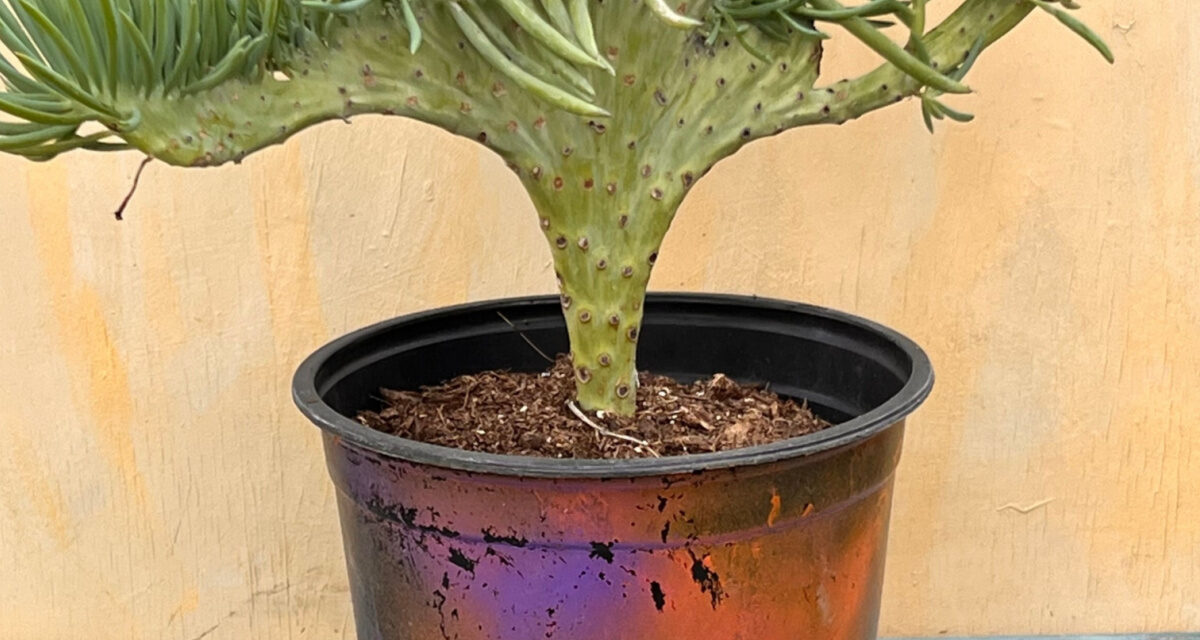Those of you who loved mermaids as a child are bound to fall in love with the Mermaid Tail succulent. Shaped like a mermaid tail, the Mermaid Tail succulent will bring a hint of the ocean into any succulent garden. Plus, you get all the benefits of any other succulent with its low maintenance, little watering, and preference for any amount of sunlight. If you haven’t added a Mermaid Tail to your garden, take a look at this unique plant and see if it fits your taste.
Plant Characteristics
Mermaid Tail succulents are sure to look unlike anything else you have in your garden!
Here are some characteristics that you can expect from Mermaid Tail succulents:
- Green, thick stems that grow upward, similar to a mermaid tail or a whale tail
- Mermaid Tail succulents can grow up to 2’ feet tall
- Less water is better for this succulent because Mermaid Tail are prone to root rot if watered too often
- If grown under proper conditions, the tips of Mermaid Tails will flower with small pinkish flowers
- Mermaid Tail succulents go dormant in the summer and grow in the winter, the opposite of most plants.
Mermaid Tail succulents can grow tall, but you’ll find that this succulent also provides ground cover in its own way. When the top of the succulent – the “tail” – gets too heavy, it will fall over but will not die off. Instead, Mermaid Tail succulents will root again and continue to grow.
Light Requirements
Mermaid Tail succulents are native to the desert, so these succulents can handle sun like a champ.
Younger plants will do better with less direct, full sunlight than mature plants. Even if this plant thrives in sunlight, too much direct light can in fact scorch the leaves of any succulent.
A sunny windowsill that gets some sun during the day in your house is one of the best places for Mermaid Tail succulents.
Water Requirements
Though Mermaid Tail succulents have a unique appearance, they do not differ greatly from other succulents in terms of watering.
Allow your Mermaid Tail succulent to dry out before you water your succulent again.
As a rule of thumb, Mermaid Tail succulents only need to be watered every two or three weeks in the spring and summer. In the fall and winter, you can cut your watering in half. You only need to water your Mermaid Tail once a month when temperatures fall.
Remember: This plant thrives in the desert. Too much water can have adverse effects on this succulent and any other.

How To Care For Mermaid Tail Succulents?
Mermaid Tails are succulents and therefore easy to care for.
You already know about light and water requirements, but what else can you do to give your Mermaid Tail the best chance at growing?
Check out some of these tips to successfully grow a Mermaid Tail succulent:
- Use a soil that is made specifically for succulents or cacti and that is well-draining
- Mermaid Tail succulents – and most succulents – grow best in terra cotta pots that can absorb extra moisture. Avoid glass or plastic containers
- Don’t worry about the pH level of your soil because Mermaid Tails don’t care about pH
Is A Mermaid Tail A Succulent Or A Cactus?
Mermaid Tails are indeed succulents.
If you’re doing your own research on Mermaid Tail succulents, you might see the question arise as to whether Mermaid Tails are a succulent or a cactus.
In the simplest terms, all cacti are succulents, but not all succulents are cacti.
The question arises about the Mermaid Tail because the stem of the Mermaid Tail succulent has spines on it, like a cactus. These spines will, however, smooth out when the plant is healthy and will not be the same as the spines you find on cacti.
Do not worry about the safety of children and animals around your Mermaid Tail because these succulents do not pose the same safety hazard as other types of household cacti.
Are Mermaid Tail Succulents Rare?
Mermaid Tail succulents are considered rare because they are mutation succulents.
This succulent variety is not technically natural, which means that Mermaid Tail succulents are more difficult to find than other varieties of succulents.
You will get a Mermaid Tail succulent when a variety of succulent called Senecio vitalis malforms through a process called fasciation.
Without getting too technical, fasciation happens when a plant’s stem enlarges and becomes flat, like the stem of Mermaid Tails.
On its own, Senecio vitalis is difficult to find, and it does not mutate all the time, which means the chances of finding Mermaid Tails even more slim.
How Do You Propagate A Mermaid Tail Succulent?
You can propagate a Mermaid Tail succulent, but it is not guaranteed that the cutting will also be mutated in a way that it will create a Mermaid Tail succulent.
The first thing you can do to give your propagation the best change at growing is to take a cutting in spring. Your Mermaid Tail succulent will start to go dormant in the spring and summer, so it will not be growing as fast.
Grab yourself a pair of sterile scissors or knife and carefully cut away part of the plant, ensuring you get part of the stem.
Once you have a cutting, you will:
- Leave the cutting alone for a few days to callous
- Plant your cutting
- Wait to water your cutting for a few days so it can acclimate to the new soil and habitat
- Begin to water your cutting until roots begin to grow, careful to not overwater and drown the plant
Have patience with your Mermaid Tail succulent, use the best soil for this succulent, and allow it time to acclimate and grow in the new environment.
With any luck, you’ll soon grow your sea of Mermaid Tail succulents – pun intended!



